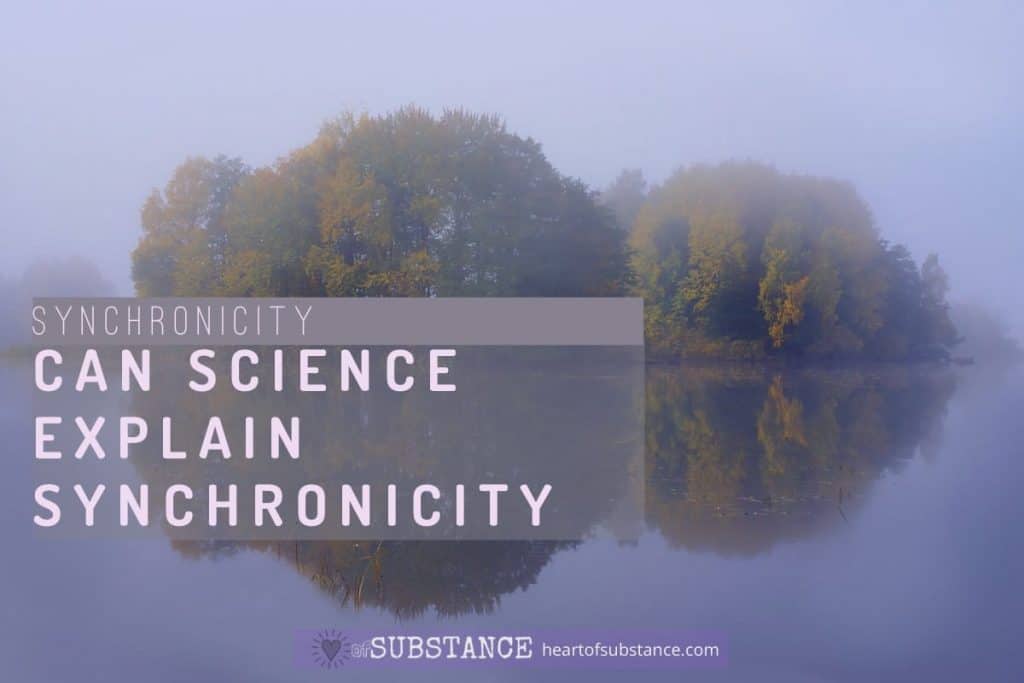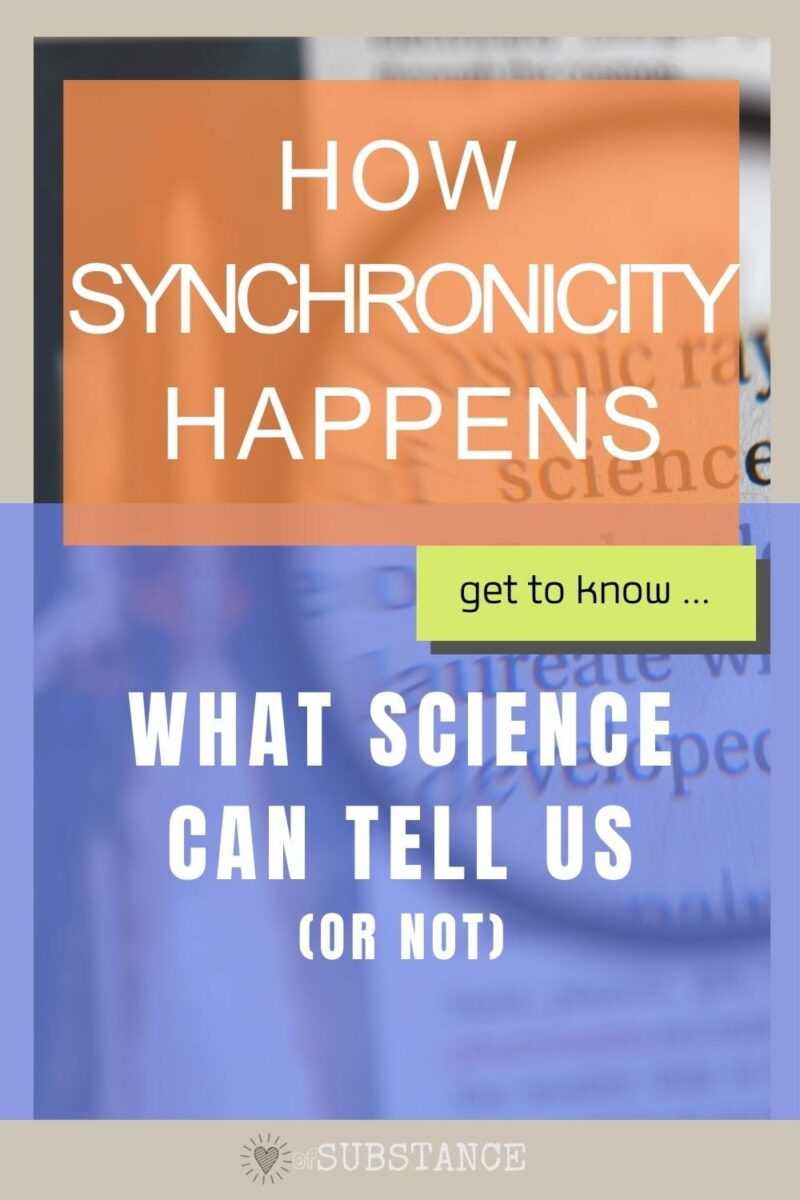You may have experienced it and, like me, are intrigued by it. So, how does synchronicity work? Can science explain it?

I can’t help but agree with Davide Wilcox’s statement in The Synchronicity Key, in that “science doesn’t matter when people refuse to believe certain facts”. The conjecture in the media today indicates we’re not listening to science. But to me, it matters.
Why?
For one, I have a huge appreciation of the scientific method and the value it adds to society as a whole.
For another, scientific research has the potential to advance many sectors of society. So, it makes sense to take notice of credible research that’s supported by the scientific community.
Is synchronicity a thing even?
Carl Jung defined synchronicity as a meaningful coincidence from his observations as a psychologist, as I mention in my article on Signs of Synchronicity – real-life examples.
Interestingly, it was Jung’s conversations with Albert Einstein over dinner that sparked his enthusiasm in this area, considering the connections between the relativity of time and space and psychic conditions.2
There’s also Austrian Biologist, Paul Kammerer’s observations on seriality, a term he gave to waves of coincidences from unknown forces, and subject of his 1919 book. Einstein himself commented it was “by no means absurd”.
I’ve written about my own and other’s synchronicity experiences (see here), one at least with the maths showing the chances.
Are there scientific explanations or are we “speculating on the weird and wonderful workings of our brains”, as Professor David Spiegelhalter of Cambridge University writes.
Let’s preface this with what the science says.
How well can science explain synchronicity?
According to LiveScience, “There is no scientific or objective way to determine whether synchronicity is valid or not”.1
What this means is that (whether it exists or not) science has no present-day way of fathoming the answer.
The more contemporary scientific method requires not just observations, but a sound and objective research design with sufficient sample size to produce significant results using statistical analysis, followed by logical interpretations of the numbers.
Then there is the issue of publishing scientific research, which requires approval through a protracted peer-review process and can mean that not all research findings see the light of day. (I can’t help but think Carl Jung’s wouldn’t have been accepted today.)
But just because the scientific method can not fathom such doesn’t make it invalid. A look back at history informs us of flaws in our thinking and our windows of ignorance (plenty comes to mind from the period before microscopes and prior to navigating the Earth).
Research on How synchronicity works
While logical interpretation, or rational thinking, can only take us so far, science is an accepted way of evaluating and making sense of the world.
Whereas neuroscience (or simply human biology) cannot complete the entire puzzle in regard to synchronicity, psychology attempts to rationalize it…
A 2015 paper published in New Ideas in Psychology covers a review and synthesis of current literature on coincidences in an attempt to provide a “rationalist perspective on the psychology of coincidence occurrence”.3
From this study, the authors conclude that egocentric bias and belief in the paranormal are the main factors associated with the frequency of meaningful coincidence accounts. Their method involved modeling coincidence in stages of detecting a coincidence, searching for a causal mechanism, and then evaluating coincidence vs causal element.
Psychology and physical sciences are yet to meet to fathom this territory.
Synchronicity is the complex and incompletely understood process by which mind and environment become temporarily connected.
Robert G. Sacco, 2017 4
The 2016 book of Bernard Beitman, a psychiatrist, introduces the idea of a ‘psychosphere’ where subtle forms of energy and information are exchanged.5 His premise is that we co-create our synchronistic experiences with the world.
As Robert Sacco, a researcher and clinical practitioner, notes in his review, Beitman’s work is descriptive, like most research into synchronicity.4
Sacco explains “Science, particularly the hard sciences, evolves through a hierarchy of types of research: descriptive, explanatory, predictive, proof, and control.”
He is probably right in saying “synchronicity researchers must migrate from conducting descriptive research projects to put more emphasis on explanatory research and ultimately strive to conduct predictive research. Only then can we claim to be a ‘science.'”
The science says…
What ‘the science says’ is essentially the accepted theory at this time. It will stay true only until an evidence-based theory with more support from the science community knocks the current thinking ‘off its perch’ so to speak.
For this to occur, the community needs to be open to new research, properly funded, and accepting of alternative thinking.
These are my thoughts…
Nobody knows everything.
If all we ever focus on is what we already know, then we will never discover what there is to know.
If we disallow wonder, diversity of thought, and speculation, we stifle discovery and opportunity.
As humans, rational thinking only takes us so far in what we know.
My philosophy is to have a questioning mind, but not a judgemental one (that would dampen intuition, discovery, and invention).
And, yes, I believe synchronicity is a thing.
See my article looking at pure coincidences or signs from the Universe?
Info sources
- Live Science: Synchronicity Definition and Meaning
- Jung, Carl G. [1952] 1993. Synchronicity: An Acausal Connecting Principle. Bollingen, CH: Bollingen Foundation. ISBN 978-0-691-01794-5. (Since included in his Collected Works 8.).
- Johansen, Mark K., Osman, Magda. 2015. Coincidences: A Fundamental Consequence of Rational Cognition. New Ideas in Psychology. Vol. 39, pp. 34-44. DOI: 10.1016/j.newideapsych.2015.07.001
- Sacco, Robert G. 2017. Advancing the New Science of Synchronicity. PsycCRITIQUES, Vol. 62, No. 13, Article 8.
- Beitman, Bernard. 2016. Connecting With Coincidence: The New Science for Using Synchronicity and Serendipity in Your Life. Deerfield Beach, FL: Health Communications, Inc., 305 pp. ISBN 978-0-75-731884-9 (paperback).
Before you go…
Science tries to explain synchronicity. Is it a real thing? Read my next article on understanding the synchronicity of numbers:
Seeing 111? Explaining Meaning and Synchronicity of Numbers




